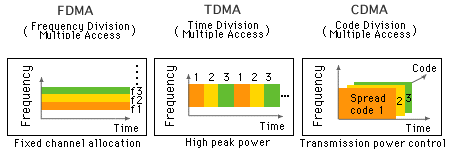Multiple Access -1.Outline
In mobile communications, it is necessary to effectively utilize limited frequency resources by enabling multiple users to share radio communications channels to simultaneously conduct communications.
The technology that is used for this purpose is called multiple access. Three systems are adopted to realize multiple access depending on way in which radio channels are separated: Frequency Division Multiple Access (FDMA) that divides by frequency, Time Division Multiple Access (TDMA) that divides by time, and Code Division Multiple Access (CDMA) that divides by spread codes using the spectrum spread.
To provide simultaneous two-way communications (duplex communications), a downlink channel from the base station to the mobile station and an uplink channel from the mobile station to the base station are necessary. Two types of duplex systems are adopted: Frequency Division Duplexing (FDD) divides by the frequency used, and Time Division Duplexing (TDD) divides the same frequency by time. FDMA mainly uses FDD, and the TDMA and CDMA systems use both FDD and TDD.

| Item | FDMA | TDMA | CDMA |
| Frequency use | Frequency reuse according to interference | Repeated use of same frequency based on interference | Same frequency use. |
| Transmit mode | Continuous transmission | Burst transmission (mobile station) Continuous transmission or burst transmission(base station) | Continuous transmission |
| Handling of different transmission rates | Difficult(use of multiple carries) Equalizer, interference suppressor necessary for higher transmission rates | Easy(Use of multiple slots, variable slot length) | Easy(use of multiple codes) |
| System characteristics | Equalizer, interference suppressor necessary for higher transmission rates. Control channels (downlinks) generally need to be synchronized. | Equalization and interference suppression needed as the degree of multiplexing increases. | With DS-CDMA, control of transmission power is essential, RAKE reception for enhanced quality and interference suppression for increased capacity are also used. |
| Inter-BS nchronization needed | Control channels (downlinks) | Synchronization needed | Synchronization needed for soft handover. |
| Example applications | Analog vehicle phones, handheld phones | TDMA-TDD:PHS, TDMA-FDD:PDC,GSM | CDMA-FDD:IS-95 |
Multiple Access
![]() Created 1999/03
Created 1999/03
